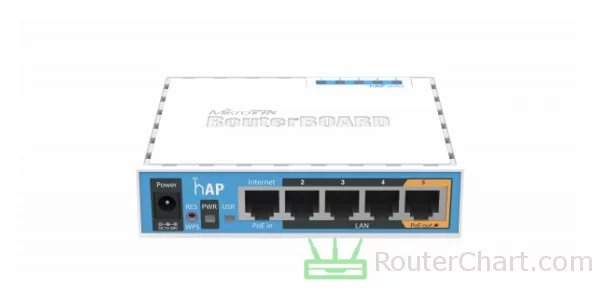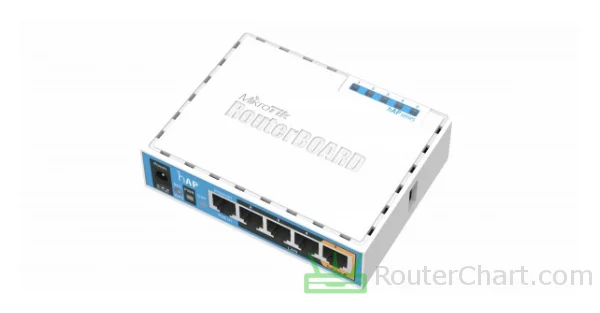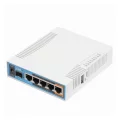MikroTik RouterBoard hAP review
MikroTik introduced the RouterBoard hAP router in 2014. It is powered by Qualcomm Atheros QCA9531 @ 650 MHz chipset, 64 MB of RAM, and 16 MB of flash memory.
Curious if this MikroTik router is a real gem? Keep scrolling!
Table of Contents
- MikroTik RouterBoard hAP specifications
- Body, dimensions, weight
- System, chipset, RAM, flash, power supply
- Network, protocols, WAN and LAN ports
- Wireless, antennas, speed, security
- Connectivity
- Features
- Administration, user interface, login information
- Links
- Verdict, Pros and Cons
- Photos
- Comparisons
Our personal experiences and opinions form the basis of this article. We aimed to share insights on a topic, and we hoped others would find it useful and inspirational. If you noticed any mistakes or missing details about the MikroTik RouterBoard hAP, please let us know.

The RouterBoard hAP has a user-friendly interface, it's suitable for users with varying levels of experience. MikroTik is known for being a respected and well-known maker of networking equipment.
MikroTik RouterBoard hAP specifications
| Brand | MikroTik |
|---|---|
| Name | RouterBoard hAP |
| Type | RB951Ui-2nD |
| Rating | |
| Launch | 2014 |
Body
| Dimensions | 113 x 89 x 28 mm |
|---|
If you plan to move a lot and need to take your router with you, the size is important. Otherwise, the size isn't too crucial.
System
| Chipset | Qualcomm Atheros QCA9531 @ 650 MHz |
|---|---|
| RAM | 64 MB |
| Flash | 16 MB |
| OS | RouterOS |
| Power supply | 24 V / 0.8 A |
The Qualcomm Atheros QCA9531 @ 650 MHz CPU provides processing power. You cannot expand the router's memory (64 MB). When selecting a router, it's essential to think about the RAM specifications.
Network
| Protocols | IPv4 |
|---|---|
| LAN ports | 4 x 10/100 Mbps |
| WAN ports | 1 x 10/100 Mbps |
| Mobile network | yes, with USB dongle |
| VPN support | no |
The RouterBoard hAP features a Fast Ethernet WAN port that has a maximum speed of 100 Mbps. You can connect the 3G/4G USB dongle to the USB port on the RouterBoard hAP router.

Wireless
| Antennas | 2 x 1.5 dBi internal |
|---|---|
| 2.4 GHz | yes |
| 5 GHz | no |
| 60 GHz | no |
| Standards | IEEE 802.11b/g/n |
| Class | N300 |
| Speed | 300 Mbps |
| Transmit power | 22 dBm |
| Security | WEP WPA WPA2 WPS |
| Guest network | no |
The router supports the 2.4 GHz Wi-Fi. Older routers have a more limited range than newer Wi-Fi standards. So, they're less suitable for larger homes or offices. The introduction of WPA2 (Wi-Fi Protected Access 2) improved upon WEP. It provides stronger security. The Wi-Fi Protected Setup (WPS) lets you join a safe wireless network with the push of a button or a simple PIN entry.
Connectivity
| USB ports | 1 x USB 2.0 |
|---|---|
| Print server | no |
| File server | no |
The USB 2 port has a maximum theoretical data transfer rate of 480 megabits per second (Mbps).
Features
| Specials | POE output |
|---|
Administration
| Default IP | 192.168.88.1 |
|---|---|
| Default username | admin |
| Default password | [blank] |
Changing the password often is a good security practice. It protects your network and devices from unauthorized access. Changing the default password improves your router's security. It reduces the risk of unauthorized individuals controlling your network.
Links
| Official site | https://mikrotik.com/ |
|---|
Pros and Cons
Every router, including this MikroTik one, has its good sides and not-so-good sides. Let's take a closer look at both to get a full understanding of what this router can do. Just remember, this is just what I think, and you might see things differently.
Pros
- sufficient memory
- 3/4G USB modem capable
- WPS friendly
- USB 2 compatible
Cons
- insufficient flash
- lack of Gigabit LAN
- Non-gigabit WAN port
- missing Wi-Fi 6 support
- lacks Wi-Fi 5 compatibility
- reduced Wi-Fi bandwidth
- incompatible with WPA3
MikroTik RouterBoard hAP photos



MikroTik RouterBoard hAP comparisons
We've noticed that many of our visitors like to compare the MikroTik RouterBoard hAP router with these popular models.
If there’s information about the MikroTik RouterBoard hAP that you would like to see on this site, then write to us.
Updated: May 25, 2024





